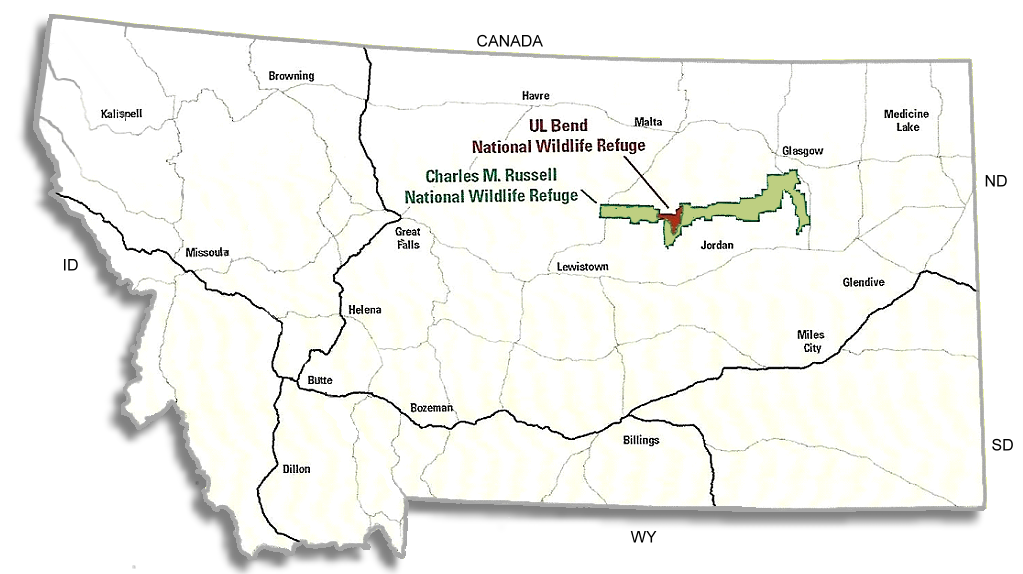Charles
M. Russell National Wildlife Refuge – A Bison Homeland
Information below is selected from federal
documents (see footnote). It is presented to clarify issues and
opportunities for bison restoration on the Refuge. The Montana
Wild Bison Restoration Coalition contends that bison restoration
on the Refuge is “appropriate” as required by the
Refuge System mission statement.
The Charles M. Russell National Wildlife Refuge (CMR) is administered
by the U. S. Fish & Wildlife Service (FWS) in the Department
of Interior. Stretched along the Missouri River and including
the UL Bend NWR, it covers over 1500 square miles. The mission
of the Refuge system includes “conservation, management
and where appropriate, restoration of wildlife and their habitats
for the benefit of present and future generations of Americans.”
Each refuge is to be managed to “ensure that the biological
integrity, diversity and environmental health of the refuge system
are maintained.”
The current 15-year Comprehensive Conservation Plan for the CMR
was approved in 2012. The Refuge is “managed for wildlife
conservation above all else.” FWS uses “natural, dynamic,
ecological processes and management activities in a balanced,
responsible manner to restore and maintain the biological diversity,
biological integrity, and environmental health of the Refuge”
and “The overall management goal at CMR is to promote biological
diversity and maintain the natural abundance of native flora and
fauna”.
“At a landscape scale” FWS will work with Montana
Fish, Wildlife & Parks (FWP) to benefit wildlife diversity,
including to “restore extirpated (eliminated) species”,
including by species reintroductions. “Restoring historical
fire-return intervals and bison would be a major step in restoring
the biological integrity and natural ecosystem functions on the
Refuge and surrounding areas.” FWS intends to “remove
interior fences to facilitate long-distance animal movements and
use of prescribed fire” in managing wildlife habitat.
“Any reintroduction of wild bison would need to be a cooperative
venture with FWP” and would be “conducted through
a public process led by FWP.” However, FWS “has taken
the position that it will not consider reintroducing wild bison
on the refuge unless FWP initiates an effort to restore wild bison
on a large landscape.”
“Before any wild bison reintroduction, FWS would complete
a cooperative wild bison management plan developed and agreed-on
by all management parties, which addresses population objectives
and management, movement of animals outside restoration areas,
genetic conservation and management, disease management, and conflict
resolution procedures.”
“Wild bison restoration would bring back what was once the
dominant herbivore in the refuge landscape. Such a project would
be a positive move toward restoration of natural ecological processes”,
which is the overall CMR goal.
Restoring bison to the CMR may necessitate some reductions in
grazing the refuge by private livestock, depending largely upon
the ultimate distribution of bison. While “livestock grazing
occurs across much of the refuge”, the CMR “supplies
less than 1% of the total” livestock forage used in the
6-county area. The dependence of individual ranches upon Refuge
forage varies, however.
In 2012, about 34% of the livestock grazing on CMR was considered
“prescriptive.” Prescriptive livestock grazing is
manipulated by season, duration and intensity, as a “habitat
management tool to achieve goals and objectives for wildlife habitat.”
It may include “long-term rest or permanent exclusion”.
In 2018, all areas of the CMR under prescriptive grazing were
rested from any livestock. CMR intends to implement prescriptive
grazing “across 50-75% of the refuge” by 2021.
Notably, an area of about 100 square miles of the Refuge (including
the UL Bend NWR), now has no livestock use. This seems to offer
the best opportunity for initiating bison restoration on the CMR.
Quotations above were taken from (1) the Record
of Decision for the Comprehensive Plan, Federal Register 77 (220):67829-30,
November, 2012; (2) the Final CMR Comprehensive Plan and Environmental
Impact Statement, available at fws.gov/refuge/Charles_m_russell;
(3) the Draft Comprehensive Plan; or directly from the CMR website,
cited here.

